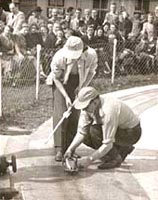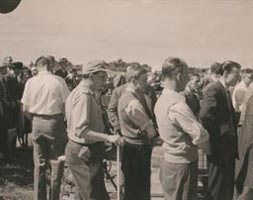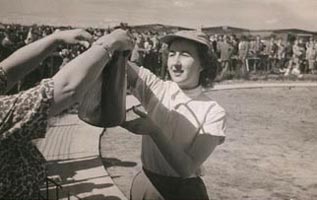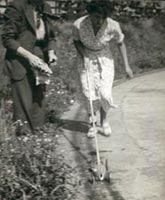

|
Home Updates Hydros Cars Engines Contacts Links Next→ Contact On The Wire |
Ian & Ivy Moore
'A Formidable Partnership'
|
|
While the name of Gerry Buck is synonymous with the development of tethered car racing in this country, it was Ian Moore who was more heavily involved, right from the earliest days of the sport, through to its decline in the mid 1950s. As well as designing and building extremely successful cars, he produced numerous articles for specialist magazines, was involved in administration at club and national level and was closely involved with the setting up of the Model Car Association in 1947. Ian William Moore was born in Staffordshire on May 14th 1920. He was known to one and all as Bill, and only seemed to use Ian for official purposes. He married the delightfully named Ivy Ironmonger from Shardlow in 1944, initially living in a flat in the centre of Derby, which meant no workshop facilities at all. This was not a problem at the time as Bill was an enthusiastic aero modeller, but as his attention turned increasingly to cars, the lack of a workshop hindered him tremendously. There is regular reference to him ‘borrowing’ workshop time or having to call on fellow club members to carry out machining operations for his car components. |
Although employed by Rolls Royce, he joined an evening class at the Derby Technical College to give himself some additional workshop time. Later, the couple moved to Spondon, on the outskirts of Derby. Together, Bill and Ivy raced their stable of cars throughout Britain and Europe, until they called it a day at the end of the 1954 season. As well as competing at club events they would travel to all the major trophy meetings, regional finals and National speed finals that would involve huge amounts of travel during a season. Further afield, a regular trip was to Italy, starting in 1952 for the first ever European Championships at Monza. This trip also included an International event, where Ivy used the number 11 car to gain second place in the 5cc class and Ian his Number 12 to tie for second in the 10cc class. Recently, it has come to light that in 1955, a car built by Alf Lee, Bob Crouch and George Reid was sent over from Australia for Ian to proxy run at the European Championships, which were in Monza that year. This was reportedly not a great success, and probably the last car he ever ran.
|
Both Ian and Ivy won numerous trophies and championships during their careers, as well as breaking British and European records along the way. In common with many others in the immediate post war period they had no car and so most of their travelling was by public transport, even the trips to Italy, which was an amazing undertaking at the time. Ivy at Barley Mow, Sunderland in May 1951 |
|
|
|
Both Bill and Ivy and their cars were in sparkling form at the 1951 Whitsun Open meeting at the Barley Mow track of the Sunderland Club. Already the holder of the 5cc record at 1/4 and 1/2 miles Ivy produced 'fireworks' with a run of 97.82mph to create a new British Open 1/4 mile Record. Bill recorded his fastest speed ever to set a new 10cc record at 126mph Bill and Ivy at Barley Mow also in May 1951 |
For Bill, the high point of his
career would probably be in his final season, where a meeting in Switzerland
resulted in a European record and class win, followed a week later by
another class win at the Supercortemaggiore Trophy meeting in Monza. (see
heading photo)
 |
 |
 |
 |
| Sunderland 1951 | Blackpool & Fylde Club track at Stanley Park Aerodrome | Ivy 'Pushing off' | |
|
On the organisational front, Bill started by representing the aero modelling interests on the committee of the newly formed Derby Club. In 1948 he became the secretary, but pressure of work created by a change in job at RR forced him to relinquish that post after a couple of years. Right: Club display with the MG centre. Also identifiable a Dooling F and and M&E Special |
|
|
|
He was also very active in the formation of the Model Car Association being largely responsible for its detailed and carefully thought out constitution. Initially he acted as the records officer, which was poetic in a way, with Ivy and him collecting so many of them. At the AGM of the MCA in 1952 he became secretary and treasurer of the association. He held this post for a number of years, culminating in being appointed the contest director for the 1954 European Championships, held at the Woodside track of the Chiltern Club. Left: Seen here with Paul Zere at the 1950 Speed Championships at Worcester. |
|
Having become a convert to Doolings, along with Cyril Catchpole, he had also formed the Dooling Enthusiasts Club, which existed as a loose association to foster interest in these motors and for sharing information. As well as all these administrative positions, Bill continued his output of articles for the specialist magazines until their demise and then took on the job of editing the car content of Model Maker in 1954. Right: Lady Mayoress presenting prizes to Bill and Ivy at the 1951 National Speed Championships at Cleethorpes. |
|
Bill and Ivy remained childless and were to divorce in the mid 60s, although, by a strange turn of events, they did end up living as near neighbours in Devon. Remarkably, Ivy continued to do Bill’s laundry, even though she had remarried. Ian W. (Bill) Moore died in 1994, with Ivy outliving him by nearly 10 years, dying in 2003.
The 'Moore Cars'
During the time he was active in the sport, Bill built 13 identifiable tether cars. Six of these were described in detail in constructional articles published in magazines, along with full sized plans available for those wanting to build a replica ‘Moore’ car, but what of the others? This leads on to the matter of the chronology of the numerous cars he built. The first was built around 1934 and his last, number 14, in 1952/53. No number 13 existed, and only 10–14 were identified by their numbers, whilst some of the others having names that they were commonly known by. It would seem therefore that there are 13 cars to account for, although several have had more than one incarnation. Using contemporary reports and articles we have attempted to identify and put the cars in what we believe is the correct order.
CAR #1 was built around 1934 whilst Bill was still at school. This was to represent a Bugatti, similar to the full sized examples he had seen racing at the nearby Donnington Park. The use of small IC engines was in its infancy and certainly beyond the reaches of a schoolboy, so motive power was by courtesy of a very large clockwork gramophone motor as was common at that time. Having the driving wheels turning at a sedate 78rpm was not going to satisfy his evident urge for ultimate speed, so the governor had to go. The first competitive race of Bill’s career was round a pole in his school hall where 2 fellow pupils, with a model of John Bolsters ‘Bloody Mary’, provided competition. The result of this race is not known.
CAR #2 In 1942 the Aeromodeller magazine had announced a competition for model racing cars, which had attracted Bill’s attention. Parts and equipment were almost non-existent at that time, so a Brown Junior was hijacked from one of his aircraft to provide the power plant. For the running gear, a set of ‘ash tray’ tyres was pressed into use, with the drive via a set of bevel gears liberated from a gas meter (hopefully not connected at the time). In this configuration the car could not be coaxed beyond 20 mph and so at this early stage in his car-racing career, the name I.W. Moore did not feature amongst the prize-winners. This foray into cars was short lived and for the next five years he remained committed to aero modelling, gaining something of a reputation for the high quality of his work, which was to be a feature of his car projects as well.
CAR #3 This car was built late in 1947 at about the same time the Derby club was being formed. With this came the first mention of ‘Mr Moore’ in the specialist magazines, when the Club press officer remarked that the car ‘was particularly beautiful’. The shape was similar to the MCN special, although smaller, with the layout following contemporary designs, using a Mills engine driving directly through just one of the rear wheels that also contained a clutch. Tether car racing was changing significantly by this time, which could have been why this relatively pedestrian car was abandoned. This lead to Bill designing and producing the first of his truly competitive cars, and the first to be recognisable as a ‘Moore Car’.
|
CAR #4 The Gardner MG Record Car The car was conceived early in 1948 and designed with three principles in mind. The overriding one being that it should be as near scale and as authentic as practically possible. Simplicity and reliability were essential as well. To be authentic the car would be, outwardly at least, a replica of EX 135 the much-modified MG Magnette that Lt Col ‘Goldie’ Gardner used so effectively for record breaking between 1938 and 1952. |
|
The most obvious aspect of the MG was the very low and smooth Railton designed streamlined body shell. Although the body shape seemed to offer plenty of room, the shallowness of it caused difficulties. Eventually a scale of 1/8th was chosen which would allow room for 3½" wheels and the rest of the running gear without compromising the scale appearance. This gave a wheelbase of 12" and an overall length nearly double that. There was still the problem of the motor, which would have to be mounted horizontally to stay within the body shell. A spur gear layout with a backbone type chassis finalised the design concept.
The choice of power unit was unusual being a 10cc Lapwing. Gerald Smith offered his engines with a variety of mounts, but one alternative included a dural channel, which picked up on bosses on the cylinder and the crankcase studs to allow the engine to be mounted horizontally. The conventional lugs were redundant so these were removed during the building of the engine
The chassis was constructed from 1¼ x ½ inch dural with separate blocks for the ball races bolted on. To allow for the small diameter tracks then in use, the chassis was built in two halves overlapping in the centre, where a locking bolt running in a slot to allow for steering held the two pieces together. The body comprised two side members with the wheel bulges carved from hard balsa, and the ‘decking’ between them planked from cigar boxes. The headrest was carved from the solid. As was normal for the period the whole body was covered with parachute nylon doped on. The superb finish was the result of 9 coats of dope, 6 of filler and 16 coats of green cellulose, rubbed down between every coat. Detailed finishing included a leather-covered seat, steering wheel, instruments, flags and a lining flash. A neat self-closing hatch was provided to get the push stick on to ‘something solid.
The ‘Moore MG’ made its first public appearance in June 1948 being entered for the Russell Trophy at the Eaton Bray Whit weekend meeting. The car was not yet a runner but it did score 65 points in the concours section, beating Lucy Gascoigne’s similar model by 15 points. Having taken 7 months to complete, the first runs under power took place in August of 48. After a number of runs it became apparent that the initial choice of gear ratio was not loading the motor sufficiently so a smaller axle gear was chosen which would give a ratio of 1.66:1. As this would involve moving the engine, chassis number one was consigned to the scrap pile and an entirely new chassis was designed and built. Chassis number two followed the same general form, but this time cast in two halves from aluminium.
Having machined the castings, the car was quickly rebuilt with modifications, which included an aluminium under tray that was ultimately to prove its Achilles heel. Back on the track, the MG was consistently lapping around 75 mph, and in this form was about to embark on an illustrious career. In response to reports that the Model Car Association would now be fully recognised, Bill decided that a British commercial engine should feature in the record book at the earliest possible stage. The MG was a little short on top speed and so the record attempt was to be for 5 miles, which involved increasing the tank size to take a quarter pint of fuel. January 16th 1949 was a windy and miserable day, but bowing to pressure from other club members, Bill sent the car on its way, and 4m 18s later the five miles was completed at an average speed of 69.77 mph. A new record had been established. To put this into perspective, however, Peter Hugo had already recorded over 66 mph for this distance with his Dooling car, but this had included stops for refuelling.
The MG continued to run throughout the 49 season, but whilst it was still one of the best looking models on the competition circuit, its weight and physical size were a distinct handicap. The airfoil shape, combined with the full under tray, endowed the car with a most undesirable characteristic, which was its willingness to become airborne. With little in the way of suspension the car was always at the mercy of any bumps on the tracks and would readily leap into the air, completing half a lap at waist height on one notable occasion. It was very quickly obvious that some ‘heavier metal’ was required, so a new car was formulated. The Gardner MG was described in the March issue of Model Car News and offered for sale in November 1949 and sold to Colonel Hedley-Briggs of the Leicester Club. Where is it now?
|
CAR #5 "MOORE SPECIAL" Early in 1949 Bill started playing about with design concepts for a new and faster car. Although high speed was the chief consideration, it also had to be simple, with as few machined parts as possible because of his lack of a workshop, and the end result should still look like a car. The use of the ‘lugless’ Lapwing would have dictated a spur drive layout but as this motor, with attached magneto was so long, the end result was always going to be too wide, and so the whole concept ended up being scrapped. |
|
At this stage, a quirk of fate was to change the future of ‘Moore Cars’. A friend in the States sent him a Dooling 61 to ‘play with’ and so the new car and all the subsequent 10s were to use this same power unit. With a clean sheet of paper several possible chassis layouts were looked at. He considered that the contemporary American cars had excessive ground clearance, dictated by the driveline and the 3½" wheels that were standard. To reduce this he angled the driveline downwards so that the motor could sit much lower to the ground.
|
|
There was not enough room with a direct-coupled engine to include a magneto, and although having given glow plugs serious consideration he decided to stick with the tried and tested coil ignition. A channel section chassis was not going to be sufficiently rigid and it would be difficult to beat a pan out of metal anywhere near thick enough, so it was back to the pattern making and castings. Initially a buck was made for a papier mache body, but a friend beat a body in two halves for him out of 16 swg aluminium, which he planished with a ball pein hammer and had welded together. With it’s flawlessly applied ‘Portland Stone’ cellulose and having followed an ‘organic’ design process; the car did end up looking suspiciously like any number of American cars. |
An early trial showed the tether brackets to be far too low and so these were sawn off to allow a new set of stainless steel brackets to be bolted on. The new brackets were bent upwards to bring the tether height slightly above the axle line. In all other respects, the car was conventional. It carried a pair of cells in a combined battery box cum coil mount. An ignition ‘knock off switch’ was fitted but no fuel shut off. Early British cars had featured elaborate suspension systems, but these were quickly abandoned for the out and out speed machines. The Special followed this trend, with the rear end of the car being a solid live axle with 3½" ZN semi pneumatic tyres and the front axle given limited movement via a rubber bush.
|
The car was run briefly to ensure that everything functioned and was taken to the Jaguar Trophy meeting at Eaton Bray on 15th May 49, for its second outing. Not only did the car ‘crack the ton’ as a first for Bill, but it was timed at 105.88 mph. The Moore Special was immediately able to run 30 mph quicker than the MG, without the tendency to become airborne. Although able to run consistently around the 105 mark, the goal posts had moved again as the best cars were now up to the 110-112 mark. |
|
In the Anglo Swedish invitation meeting the car recorded its best ¼ mile speed at 108.5 mph. Close, but still needing that extra few mph. Answer, yet another car.
Following the lead from Gerry Buck. IWM entered the Drysdale Trophy as a ’one man team’ running both the Gardner MG and the Special, which involved stopping one car, changing the line to the next car and pushing of to complete a single timed run. The trophy was his by a margin of 2 seconds. The ‘Moore Special was described in the July 49 issue of MCN.
Car #6 Not for the first time, the bulk of a ‘Moore’ design ended up in the scrap bin. During the 1949 season Bill was reminded pointedly and repeatedly that he had been promising to build Ivy a car. She was keen to join him in competing at the numerous meetings they attended. Conscious of his promise, he had obtained a McCoy 29 some time previously for this very purpose, but having not yet got ‘round to it’ the McCoy had been passed on. The ETA 29 was available again and so this British motor was the basis for the first of the Moore 5cc cars. Working from the manufacturers figures and estimated speed, the gearing and tyre size was calculated and design drawn up accordingly. By now pattern making was second nature and soon he had a spur mount cast up and machined. Unfortunately, at this stage he came to realise that his ‘guestimation’ over the gearing and tyre size was very seriously wrong and that it was not going to be worth continuing with the car in this form. The act of scrapping this project led directly to one of the most successful cars from the Moore stable.
|
CAR #7 MOORE DOOLING SPECIAL With the ETA car being a non-starter, the season was coming to an end, and so it gave Bill a little thinking time. It must have become apparent to him by now, that to be competitive, the Dooling 29 was the only realistic route to follow. Having obtained a motor and recalculated the figures, he came up with a 2:1 gear ratio, which would still be appropriate for 3½" wheels and tyres. Luckily he was able to avoid further pattern making and machining, as Jack Cook from Sunderland was able to supply him with a suitable motor mount for the Dooling. |
|
The layout was conventional for a spur drive car, with the lower half of the pan very shallow and beaten out of 14 SWG aluminium, with the much deeper top from 22 SWG. For the first time, a ‘pan handle’ appears on a Moore car. Otherwise, with the exception of the fuel ‘knock off’ the interior of the car is very uncluttered and ‘business like’. Dooling F front tyres were pressed into service on the rear, whilst the front wheels and tyres were purloined from the 10cc Special and mounted on a ZN type drop axle.
|
|
As this was to be the first of his cars with glow plug ignition, a great deal of thought went into ‘getting the car away’ and in particular how to connect an external battery so the car did not tow it off around the track. The photo of the pan shows the device that allowed connection to a battery carried on the famous push stick. After the debacle of the ETA car, this car was only really intended to be a test bed for the gearing. However, to quote Bill (the car) "exceeded our most fervent hopes". Very quickly the car was into the high 80s and improving. At the opening of the new Cleethorpes track on 27th August, Ivy pushed the car off to a new open record of 96.25 mph., receiving her prize from motorcycle racer, Freddie Frith. |
The car was to provide the backbone of the Moore stable for the rest of their careers. It was able to run consistently in the 90s and recorded a whole raft of trophy and competition wins. In 1951 Ivy pushed the open 5cc record to 97.83 mph with the car. As often as possible, Bill used to prise it from his wife’s grasp for various events, including another one man team effort in the Drysdale Trophy.
The car was described in Model Maker in January 1951 and featured as a fully detailed constructional article from August to November 52.
©copyrightOTW2012